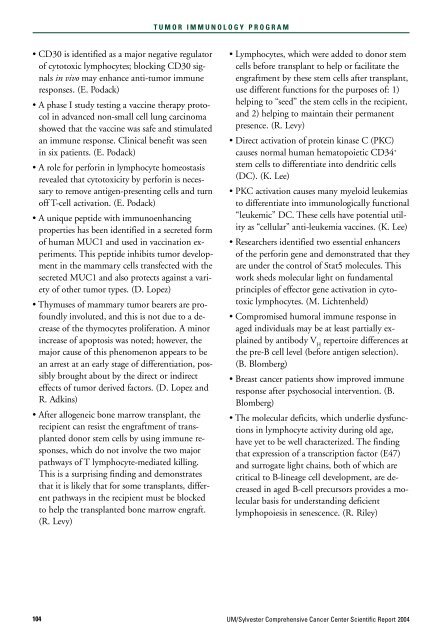SCIENTIFIC REPORT 2004 - Sylvester Comprehensive Cancer Center
SCIENTIFIC REPORT 2004 - Sylvester Comprehensive Cancer Center
SCIENTIFIC REPORT 2004 - Sylvester Comprehensive Cancer Center
You also want an ePaper? Increase the reach of your titles
YUMPU automatically turns print PDFs into web optimized ePapers that Google loves.
T U M O R I M M U N O L O G Y P R O G R A M<br />
• CD30 is identified as a major negative regulator<br />
of cytotoxic lymphocytes; blocking CD30 signals<br />
in vivo may enhance anti-tumor immune<br />
responses. (E. Podack)<br />
• A phase I study testing a vaccine therapy protocol<br />
in advanced non-small cell lung carcinoma<br />
showed that the vaccine was safe and stimulated<br />
an immune response. Clinical benefit was seen<br />
in six patients. (E. Podack)<br />
• A role for perforin in lymphocyte homeostasis<br />
revealed that cytotoxicity by perforin is necessary<br />
to remove antigen-presenting cells and turn<br />
off T-cell activation. (E. Podack)<br />
• A unique peptide with immunoenhancing<br />
properties has been identified in a secreted form<br />
of human MUC1 and used in vaccination experiments.<br />
This peptide inhibits tumor development<br />
in the mammary cells transfected with the<br />
secreted MUC1 and also protects against a variety<br />
of other tumor types. (D. Lopez)<br />
• Thymuses of mammary tumor bearers are profoundly<br />
involuted, and this is not due to a decrease<br />
of the thymocytes proliferation. A minor<br />
increase of apoptosis was noted; however, the<br />
major cause of this phenomenon appears to be<br />
an arrest at an early stage of differentiation, possibly<br />
brought about by the direct or indirect<br />
effects of tumor derived factors. (D. Lopez and<br />
R. Adkins)<br />
• After allogeneic bone marrow transplant, the<br />
recipient can resist the engraftment of transplanted<br />
donor stem cells by using immune responses,<br />
which do not involve the two major<br />
pathways of T lymphocyte-mediated killing.<br />
This is a surprising finding and demonstrates<br />
that it is likely that for some transplants, different<br />
pathways in the recipient must be blocked<br />
to help the transplanted bone marrow engraft.<br />
(R. Levy)<br />
• Lymphocytes, which were added to donor stem<br />
cells before transplant to help or facilitate the<br />
engraftment by these stem cells after transplant,<br />
use different functions for the purposes of: 1)<br />
helping to “seed” the stem cells in the recipient,<br />
and 2) helping to maintain their permanent<br />
presence. (R. Levy)<br />
• Direct activation of protein kinase C (PKC)<br />
causes normal human hematopoietic CD34 +<br />
stem cells to differentiate into dendritic cells<br />
(DC). (K. Lee)<br />
• PKC activation causes many myeloid leukemias<br />
to differentiate into immunologically functional<br />
“leukemic” DC. These cells have potential utility<br />
as “cellular” anti-leukemia vaccines. (K. Lee)<br />
• Researchers identified two essential enhancers<br />
of the perforin gene and demonstrated that they<br />
are under the control of Stat5 molecules. This<br />
work sheds molecular light on fundamental<br />
principles of effector gene activation in cytotoxic<br />
lymphocytes. (M. Lichtenheld)<br />
• Compromised humoral immune response in<br />
aged individuals may be at least partially explained<br />
by antibody V H<br />
repertoire differences at<br />
the pre-B cell level (before antigen selection).<br />
(B. Blomberg)<br />
• Breast cancer patients show improved immune<br />
response after psychosocial intervention. (B.<br />
Blomberg)<br />
• The molecular deficits, which underlie dysfunctions<br />
in lymphocyte activity during old age,<br />
have yet to be well characterized. The finding<br />
that expression of a transcription factor (E47)<br />
and surrogate light chains, both of which are<br />
critical to B-lineage cell development, are decreased<br />
in aged B-cell precursors provides a molecular<br />
basis for understanding deficient<br />
lymphopoiesis in senescence. (R. Riley)<br />
104<br />
UM/<strong>Sylvester</strong> <strong>Comprehensive</strong> <strong>Cancer</strong> <strong>Center</strong> Scientific Report <strong>2004</strong>
















